Sustainable Supply Chain Management: A Comprehensive Systematic Review of Industrial Practices
Abstract
:1. Introduction
2. Research Methodology
2.1. Literature Search
2.2. Descriptive Analysis
2.3. Category Selection
2.4. Evaluation Stage
3. Comprehensive Framework
3.1. Manufacturing
3.1.1. Green Production
3.1.2. Licensing and Outsourcing
3.1.3. Lean Philosophy
3.1.4. Product and Service (P&S)
3.1.5. Maintenance
3.2. Design
3.2.1. Sustainable Design: Product, Process, and Infrastructure
3.2.2. SC Design
3.2.3. Innovation
3.3. Logistics
3.3.1. Inventory Management
3.3.2. Sustainable Distribution
3.3.3. Market Management
3.3.4. Reverse and Green Logistics
3.3.5. Waste Management
3.4. Supply Planning and Procurement
3.4.1. Resource Management
3.4.2. Purchasing
3.4.3. Supplier Management
3.4.4. Coding
3.5. Management Information Systems
3.5.1. Information Management
3.5.2. Communication, Conversation, Collaboration, Cooperation, Coordination, and Contribution (6Cs)
3.6. Quality Performance
3.6.1. Certifications and Standards
3.6.2. Quality Management
3.6.3. Evaluation and Assessment
3.7. Safety and Security
3.7.1. Health and Safety Management
3.7.2. Risk Management
3.8. Ethics and Social Responsibility
3.8.1. Human Resources and Rights
3.8.2. Humanitarian Activities
3.8.3. Behavior Practices
3.8.4. Fairness
3.9. Financial Management
3.9.1. Cost Management
3.9.2. Reward and Incentive Systems
3.9.3. Investment
3.10. Structural Management
3.10.1. Organizational Management
3.10.2. Stakeholder Management
3.10.3. Integration and Joint Activities
3.10.4. Rules and Regulations
3.11. Promotional Programs
3.11.1. Training and Learning (T&L)
3.11.2. Supportive Plans and Programs
3.11.3. Awareness
4. Results
| Author (Year) | Practices Class | Industry | Case Country | Type of Practice | Data Collection | Data Analysis Technique | ||||||||||
|---|---|---|---|---|---|---|---|---|---|---|---|---|---|---|---|---|
| A | B | C | D | E | F | G | H | I | J | K | ||||||
| Pagell and Wu [24] | bc | b | d | a–c * | ab | a–c | b | a | ab | ac | b | Multiple | General | V | QCCA | |
| Faisal [65] | c | ab | c | d | bc | DC ** | General | LR, V | ISM | |||||||
| Gimenez and Tachizawa [91] | c | ab | b | a–c | ac | ab | General | For suppliers | SLR | TA | ||||||
| Tachizawa, Thomsen [103] | ac | c | a | Different sectors | Spain | GSCM | SSQ | MSA (cluster analysis) | ||||||||
| Walker and Jones [104] | d | bc | ab | c | ab | Aerospace, retail (Pharmaceuticals, food, and drink) | UK | General | V | QCCA | ||||||
| Wittstruck and Teuteberg [100] | d | a | a | ab | Electrical | Germany | Recycling networks | SLR | DTA | |||||||
| Zailani, Jeyaraman [75] | a | a | e | ab | c | Manufacturing (400 firms) | Malaysia | GSCM | SSQ | MSA (C&R) | ||||||
| Delai and Takahashi [64] | c | a | Retail | Brazil | E | V | QCCA | |||||||||
| Beske and Seuring [105] | c | ab | c | b | bc | b | General | General | SLR | TA | ||||||
| Beske, Land [93] | c | b | c | b | bc | ab | Food | Dynamic capabilities | SLR | TA | ||||||
| Diabat, Kannan [73] | d | c | ab | a | ab | ac | d | Textile | India | 13 selected | LR, V | ISM | ||||
| Mitra and Datta [59] | a | a | b–e | a–c | ac | c | b | c | Manufacturing | India | GSCM | SSQ | SEM | |||
| Stiller and Gold [49] | b | c | ab | b | Seed sector | India | S | V | QA | |||||||
| de Sousa Jabbour, de Oliveira Frascareli [44] | a | b | b | a | c | Leaders | Brazil | GSCM | V | QCCA | ||||||
| Jia, Diabat [70] | a | a | de | a | b | ac | a | ab | Mining and Minerals | India | SSCM | LR, V | ISM | |||
| Luthra, Garg [63] | c | c | ac | a | ab | a | bd | a–c | Automobile | India | GSCM | SSQ | EFA | |||
| Marshall, McCarthy [45] | ab | cd | ac | d | b | Ireland | S | SSQ | MSA (Hierarchical R) | |||||||
| Wan Ahmad, de Brito [81] | bc | bc | a | Oil and gas (30 companies) | General | SSQ | Descriptive | |||||||||
| Wan Ahmad, Rezaei [43] | de | a | de | b–d | ab | c | ab | b | ac | ab | Oil and gas | Firm internal factors | QD, V | MSA (EFA, R) | ||
| Esfahbodi, Zhang [62] | a | b | ab | b | ac | c | Manufacturing | Iran, China | E | SSQ | MSA (Multiple R) | |||||
| Gopal and Thakkar [48] | bc | cd | ab | a | b | a–d | ac | Automotive | India | ES | SSQ, QD | SEM | ||||
| Gopal and Thakkar [94] | c | c | b | c | b | a | c | Automobile | India | General | SSQ | SEM | ||||
| Kusi-Sarpong, Sarkis [68] | c | de | c | ab | ac | b | c | ab | Mining | Ghana | GSCM | LR, V | DEMATEL | |||
| Lu, Lai [47] | a | e | d | ab | c | a | d | ab | Maritime | Taiwan | Inter/external collaboration | SSQ | SEM | |||
| Mejías, Paz [35] | ac | ac | ad | bc | b | bc | b | b | c | General | General | SLR | DTA | |||
| Chen and Kitsis [87] | ab | b | General | Relational | SLR | TA | ||||||||||
| Das [56] | a | a | ab | c | ab | a | ab | a | Manufacturing | India | ES, OP | SSQ | EFA | |||
| Esfahbodi, Zhang [61] | a | b | ab | b | a | c | d | Manufacturing (146 firms) | UK | EG | SSQ | SEM | ||||
| Golini, Moretto [38] | d | a–c | b–e | abd | ab | c | bd | b | c | b | Food | Italy | Economic, E | V | QCCA | |
| Kausar, Garg [53] | c | c | a | a | b | abd | b | India | 12 selected | LR, V | ISM | |||||
| Köksal, Strähle [88] | b | a | b | b | Textile | S | SLR | TA | ||||||||
| Mathivathanan and Haq [84] | d | c | ac | b | d | ab | Automotive | India | 10 common SSCM | QD, V | MSA (ANOVA) | |||||
| Oelze [89] | b | ab | Textile | Germany | IE | V | QCCA | |||||||||
| Raut, Narkhede [28] | ad | a | cd | ab | ab | a | a | a | ab | abd | ab | Oil and gas | India | 32 selected | LR, V | ISM |
| Wu, Santoso [54] | c | e | a | a | Coal | Indonesia | General | LR, V | DEMATEL-ANP | |||||||
| Ciccullo, Pero [95] | ad | d | ac | ab | General | Agile and sustainable | SLR | DTA | ||||||||
| Croom, Vidal [106] | ab | US | S | SSQ | MSA (CFA, R) | |||||||||||
| Das [85] | a–c | abde | c | a | a | bc | a | Manufacturing | India | ES, OP, SCI | SSQ | SEM | ||||
| Das [60] | a | a | a–c | a | a | ab | c | Manufacturing | India | ES, OP, SCI | SSQ | SEM | ||||
| Hussain, Ajmal [99] | c | e | a | b | ab | ad | abd | c | Healthcare | UAE | S | SSQ | SEM | |||
| Hong, Zhang [101] | a | b | b | ab | Manufacturing | China | Five categories | SSQ | SEM | |||||||
| Das [30] | acd | ac | de | a | b | a–c | cd | bc | Lean | Secondary data | Mathematical modelling | |||||
| Luthra and Mangla [37] | d | c | b | c | c | ab | Automotive | India | Nine key strategies | LR, V | ISM-fuzzy MICMAC | |||||
| Mathivathanan, Kannan [67] | ad | ac | d | b | b | ac | a | b | c | ab | Automotive | India | ESG | LR, V | DEMATEL | |
| Moretto, Macchion [76] | a | b | abd | ab | ac | ab | a | a–c | Fashion | Ita, Ger, Fra | ES | V | QCCA | |||
| Prasad, Pradhan [78] | cd | b | c | a | c | ad | ab | Steel sector | India | General | SSQ | EFA | ||||
| Thong and Wong [71] | de | acd | ac | ab | abd | b | General | Malaysia | General | SSQ | SEM | |||||
| Vargas, Mantilla [40] | ad | ab | cd | bd | ab | ac | a | ab | ab | ad | ab | Different sectors (industry (59.5%), services (30.2%), commerce (6.3%), agriculture (1.6%), mining (1.6%), and construction (0.8%)) | Colombia | E | SSQ | PLS-SEM |
| Wang and Dai [42] | ae | a | ce | b | b | ac | a | ab | cd | ab | General (172 firms) | China | IE management | SSQ | SEM | |
| Wu, Zhang [96] | e | c | bc | a | a | ab | a | ad | ab | Manufacturing | China | Economic, ES | SSQ | SEM | ||
| Andalib Ardakani and Soltanmohammadi [74] | de | ab | b | a | a | d | b | General | Iran | GSCM | SSQ | PLS-SEM | ||||
| Baliga, Raut [77] | a | a | cde | b | a | a | a | General | E | SLR | DTA | |||||
| Bressanelli, Perona [97] | ab | b | c | Household appliances | Italy | SC redesign for the CE | V | QCCA | ||||||||
| Broemer, Brandenburg [107] | abc | ac | ac | ac | a | Chemical | Germany | Intra/inter organizational | Single case | QA | ||||||
| Cousins, Lawson [86] | c | d | ab | c | Manufacturing | UK | GSCM | SSQ | MSA(EFA) | |||||||
| Duque-Uribe, Sarache [57] | a | ab | abde | a–c | ab | b | ac | c | ab | Healthcare | General | SLR | TA | |||
| Jadhav, Orr [82] | de | ad | ab | c | b | Manufacturing | Australia | Internal ES | SSQ | SEM | ||||||
| León-Bravo, Caniato [39] | a d | e | ab | ab | c | ab | ab | Food | Italy | A few selected | V | QCCA | ||||
| Li, Fang [29] | ad | a | cd | b | abd | a | b | General | China | For supplier | LR, V | TOPSIS | ||||
| Zimon, Tyan [72] | a | c | bde | ab | b | ac | c | b | Manufacturing | Taiwan | Reactive, cooperative, dynamic | SLR | TA | |||
| Balon [108] | de | b | ab | General | GSCM | SLR | Bibliometric | |||||||||
| Choudhary, Kumar [32] | a | c | d | b | b | b | b | Automotive | India | E | LR, V | DEMATEL | ||||
| Ciccullo, Pero [36] | ad | b | bc | b | a | Different industries (10 exploratory case studies in different industries and four explanatory cases in the furniture industry) | Canada, US, Italy | General | V | QCCA | ||||||
| Cloutier, Oktaei [90] | b | ab | c | b | cd | Collaborative | SLR | DTA | ||||||||
| Geyi, Yusuf [46] | d | a | c | b | ac | a | a | c | ab | Manufacturing | UK | Agile practices | SSQ | SEM | ||
| Gloet and Samson [83] | c | c | ab | a | b | ac | ab | Food and beverage | Australia | Knowledge and innovation management | V | QCCA | ||||
| Heidary Dahooie, Zamani Babgohari [41] | e | a | d | b | ab | ab | Mining | Iran | General | LR, V | Fuzzy DEMATEL | |||||
| Hong, Guo [52] | c | c | b | b | b | ad | b | Manufacturing (Chinese manufacturers in the Yangtze River Delta region: 209 firms) | China | SSCM | SSQ | MSA (C&R) | ||||
| Islam, Perry [31] | ad | c | be | ab | a | ac | ab | Textiles | ES | SLR | DTA | |||||
| Jabbour, Janeiro [109] | c | ab | b | d | Case companies (Brazilian companies that have ISO9001 regarding the level/intensity of adoption of practices/initiatives for justice in supply chains) | Brazil | S | SSQ | MSA (C&R) | |||||||
| Jaegler and Goessling [69] | bce | a | b | Luxury goods (11 European luxury good companies) | France | Specified for industry | SSQ | USA | ||||||||
| Jia, Yin [110] | d | de | Textile | PDS, E | SLR | DTA | ||||||||||
| Jia, Zhang [98] | b | General | Financial | SLR | DTA | |||||||||||
| Kumar, Moktadir [51] | c | b | c | a | b | a | ab | Footwear | Bangladesh | Behavioral | LR, V | DEMATEL | ||||
| Wang, Zhang [66] | c | d | b | a | bc | b | b | General (172 firms) | China | General (IE) | SSQ | SEM | ||||
| Laosirihongthong, Samaranayake [102] | a | bd | b | Electronics (electronics parts/components manufacturing organizations) | Thailand | Five selected | LR, V | Fuzzy AHP | ||||||||
| Mani, Jabbour [92] | a | ab | bd | SME manufacturer | India | S | SSQ | SEM | ||||||||
| Narimissa, Kangarani-Farahani [80] | c | ce | b | c | a | b | b | Oil and gas | Iran | 112 selected | SLR | Delphi | ||||
| Stekelorum [111] | b | SME general | CSR practices in SC of SMEs | SLR | DTA | |||||||||||
| Silvestre, Silva [55] | ad | c | ce | a | ab | ac | a-c | Five SC cases | Brazil | General | V | QCCA | ||||
| Warasthe, Schulz [79] | bc | ab | ac | c | Textile | Germany Ethiopia | Internals and externals | V | QCCA | |||||||
| Yadav, Luthra [34] | ae | b | cd | ab | ab | b | a | b | c | bc | Automotive | India | Industry 4.0 | LR, V | BWM-ELECTRE | |
| Zimon, Tyan [58] | a | a | abde | ab | b | c | b | b | UN SDGs | General | SLR | TA | ||||
| Kouhizadeh, Saberi [112] | a | Blockchain technology | LR, V | DEMATEL | ||||||||||||
| Qorri, Gashi [33] | a | ac | bd | b–d | b | ac | ad | bc | ab | S | MAR | MA-SA | ||||
| Sabuj, Ali [50] | c | d | ab | a | cd | a–c | Garment | Bangladesh | General | LR, V | ISM | |||||
5. Discussion and Future Research
6. Conclusions
Author Contributions
Funding
Institutional Review Board Statement
Informed Consent Statement
Data Availability Statement
Conflicts of Interest
References
- Giunipero, L.C.; Hooker, R.E.; Denslow, D. Purchasing and supply management sustainability: Drivers and barriers. J. Purch. Supply Manag. 2012, 18, 258–269. [Google Scholar] [CrossRef]
- Carter, C.R.; Jennings, M.M. Logistics social responsibility: An integrative framework. J. Bus. Logist. 2002, 23, 145–180. [Google Scholar] [CrossRef]
- Lis, A.; Sudolska, A.; Tomanek, M. Mapping research on sustainable supply-chain management. Sustainability 2020, 12, 3987. [Google Scholar] [CrossRef]
- Sánchez-Flores, R.B.; Cruz-Sotelo, S.E.; Ojeda-Benitez, S.; Ramírez-Barreto, M.E. Sustainable supply chain management—A literature review on emerging economies. Sustainability 2020, 12, 6972. [Google Scholar] [CrossRef]
- Sarkis, J. Manufacturing’s role in corporate environmental sustainability-Concerns for the new millennium. Int. J. Oper. Prod. Manag. 2001, 21, 666–686. [Google Scholar] [CrossRef]
- Morali, O.; Searcy, C. A review of sustainable supply chain management practices in Canada. J. Bus. Ethics 2013, 117, 635–658. [Google Scholar] [CrossRef]
- Ashby, A.; Leat, M.; Hudson-Smith, M. Making connections: A review of supply chain management and sustainability literature. Supply Chain. Manag. Int. J. 2012, 17, 497–516. [Google Scholar] [CrossRef]
- Ahi, P.; Searcy, C. An analysis of metrics used to measure performance in green and sustainable supply chains. J. Clean.Prod. 2015, 86, 360–377. [Google Scholar] [CrossRef]
- Taticchi, P.; Garengo, P.; Nudurupati, S.S.; Tonelli, F.; Pasqualino, R. A review of decision-support tools and performance measurement and sustainable supply chain management. Int. J. Prod. Res. 2015, 53, 6473–6494. [Google Scholar] [CrossRef]
- Moreno-Camacho, C.A.; Montoya-Torres, J.R.; Jaegler, A.; Gondran, N. Sustainability metrics for real case applications of the supply chain network design problem: A systematic literature review. J. Clean. Prod. 2019, 231, 600–618. [Google Scholar] [CrossRef]
- Paul, A.; Shukla, N.; Paul, S.; Trianni, A. Sustainable supply chain management and multi-criteria decision-making methods: A systematic review. Sustainability 2021, 13, 7104. [Google Scholar] [CrossRef]
- Barbosa-Póvoa, A.P.; da Silva, C.; Carvalho, A. Opportunities and challenges in sustainable supply chain: An operations research perspective. Eur. J. Oper. Res. 2018, 268, 399–431. [Google Scholar] [CrossRef]
- Saeed, M.A.; Kersten, W. Drivers of sustainable supply chain management: Identification and classification. Sustainability 2019, 11, 1137. [Google Scholar] [CrossRef] [Green Version]
- Koberg, E.; Longoni, A. A systematic review of sustainable supply chain management in global supply chains. J. Clean. Prod. 2019, 207, 1084–1098. [Google Scholar] [CrossRef]
- Alinaghian, L.; Qiu, J.; Razmdoost, K. The role of network structural properties in supply chain sustainability: A systematic literature review and agenda for future research. Supply Chain Manag. Int. J. 2020, 26, 192–211. [Google Scholar] [CrossRef]
- Nilsson, F.; Göransson, M. Critical factors for the realization of sustainable supply chain innovations-model development based on a systematic literature review. J. Clean. Prod. 2021, 296, 126471. [Google Scholar] [CrossRef]
- Pimenta, H.C.D.; Ball, P.; Salonitis, K. Supply chain environmental and social sustainability practice diffusion: Bibliometrics, content analysis and conceptual framework. Corp. Soc. Responsib. Environ. Manag. 2021, 28, 1870–1890. [Google Scholar] [CrossRef]
- Thamsatitdej, P.; Boon-Itt, S.; Samaranayake, P.; Wannakarn, M.; Laosirihongthong, T. Eco-design practices towards sustainable supply chain management: Interpretive structural modelling (ISM) approach. Int. J. Sustain. Eng. 2017, 10, 326–337. [Google Scholar] [CrossRef]
- Bureau of National Affairs. The Sustainability Imperative: Business and Investor Outlook; 2018 Bloomberg Sustainable Business & Finance Survey; Nuveen and BNP Paribas: Paris, France, 2018. [Google Scholar]
- Shekarian, E. A review of factors affecting closed-loop supply chain models. J. Clean. Prod. 2020, 253, 119823. [Google Scholar] [CrossRef]
- Shekarian, E.; Flapper, S.D. Analyzing the structure of closed-loop supply chains: A game theory perspective. Sustainability 2021, 13, 1397. [Google Scholar] [CrossRef]
- Tranfield, D.; Denyer, D.; Smart, P. Towards a methodology for developing evidence-informed management knowledge by means of systematic review. Br. J. Manag. 2003, 14, 207–222. [Google Scholar] [CrossRef]
- Shekarian, E.; Kazemi, N.; Abdul-Rashid, S.H.; Olugu, E.U. Fuzzy inventory models: A comprehensive review. Appl. Soft Comput. 2017, 55, 588–621. [Google Scholar] [CrossRef]
- Pagell, M.; Wu, Z. Building a more complete theory of sustainable supply chain management using case studies of 10 exemplars. J. Supply Chain Manag. 2009, 45, 37–56. [Google Scholar] [CrossRef]
- Schober, A.; Kittel, C.; Baumgartner, R.J.; Füllsack, M. Identifying dominant topics appearing in the Journal of Cleaner Production. J. Clean. Prod. 2018, 190, 160–168. [Google Scholar] [CrossRef]
- Editorial Note. J. Clean. Prod. 2020, 260, 121651. [CrossRef]
- Mey, G.; Mruck, K. Handbuch qualitative Forschung in der Psychologie; Springer: Berlin/Heidelberg, Germany, 2010. [Google Scholar]
- Raut, R.D.; Narkhede, B.; Gardas, B.B. To identify the critical success factors of sustainable supply chain management practices in the context of oil and gas industries: ISM approach. Renew. Sustain. Energy Rev. 2017, 68, 33–47. [Google Scholar] [CrossRef]
- Li, J.; Fang, H.; Song, W. Sustainable supplier selection based on SSCM practices: A rough cloud TOPSIS approach. J. Clean. Prod. 2019, 222, 606–621. [Google Scholar] [CrossRef]
- Das, K. Integrating lean systems in the design of a sustainable supply chain model. Int. J. Prod. Econ. 2018, 198, 177–190. [Google Scholar] [CrossRef]
- Islam, M.M.; Perry, P.; Gill, S. Mapping environmentally sustainable practices in textiles, apparel and fashion industries: A systematic literature review. J. Fash. Mark. Manag. Int. J. 2020, 25, 331–353. [Google Scholar] [CrossRef]
- Choudhary, S.; Kumar, A.; Luthra, S.; Garza-Reyes, J.A.; Nadeem, S.P. The adoption of environmentally sustainable supply chain management: Measuring the relative effectiveness of hard dimensions. Bus. Strategy Environ. 2020, 29, 3104–3122. [Google Scholar] [CrossRef]
- Qorri, A.; Gashi, S.; Kraslawski, A. Performance outcomes of supply chain practices for sustainable development: A meta-analysis of moderators. Sustain. Dev. 2021, 29, 194–216. [Google Scholar] [CrossRef]
- Yadav, G.; Luthra, S.; Jakhar, S.K.; Mangla, S.K.; Rai, D.P. A framework to overcome sustainable supply chain challenges through solution measures of industry 4.0 and circular economy: An automotive case. J. Clean. Prod. 2020, 254, 120112. [Google Scholar] [CrossRef]
- Mejías, A.M.; Paz, E.; Pardo, J.E. Efficiency and sustainability through the best practices in the logistics social responsibility framework. Int. J. Oper. Prod. Manag. 2016, 36, 164–199. [Google Scholar] [CrossRef]
- Ciccullo, F.; Pero, M.; Gosling, J.; Caridi, M.; Purvis, L. When sustainability becomes an order winner: Linking supply uncertainty and sustainable supply chain strategies. Sustainability 2020, 12, 6009. [Google Scholar] [CrossRef]
- Luthra, S.; Mangla, S.K. When strategies matter: Adoption of sustainable supply chain management practices in an emerging economy’s context. Resour. Conserv. Recycl. 2018, 138, 194–206. [Google Scholar] [CrossRef]
- Golini, R.; Moretto, A.; Caniato, F.; Caridi, M.; Kalchschmidt, M. Developing sustainability in the Italian meat supply chain: An empirical investigation. Int. J. Prod. Res. 2017, 55, 1183–1209. [Google Scholar] [CrossRef]
- León-Bravo, V.; Caniato, F.; Caridi, M. Sustainability in multiple stages of the food supply chain in Italy: Practices, performance and reputation. Oper. Manag. Res. 2019, 12, 40–61. [Google Scholar] [CrossRef]
- Vargas, J.R.C.; Mantilla, C.E.M.; de Sousa Jabbour, A.B.L. Enablers of sustainable supply chain management and its effect on competitive advantage in the Colombian context. Resour. Conserv. Recycl. 2018, 139, 237–250. [Google Scholar] [CrossRef]
- Heidary Dahooie, J.; Zamani Babgohari, A.; Meidutė-Kavaliauskienė, I.; Govindan, K. Prioritising sustainable supply chain management practices by their impact on multiple interacting barriers. Int. J. Sustain. Dev. World Ecol. 2020, 28, 267–290. [Google Scholar] [CrossRef]
- Wang, J.; Dai, J. Sustainable supply chain management practices and performance. Ind. Manag. Data Syst. 2018, 118, 2–21. [Google Scholar] [CrossRef]
- Wan Ahmad, W.N.K.; Rezaei, J.; Tavasszy, L.A.; de Brito, M.P. Commitment to and preparedness for sustainable supply chain management in the oil and gas industry. J. Environ. Manag. 2016, 180, 202–213. [Google Scholar] [CrossRef]
- de Sousa Jabbour, A.B.L.; de Oliveira Frascareli, F.C.; Jabbour, C.J.C. Green supply chain management and firms’ performance: Understanding potential relationships and the role of green sourcing and some other green practices. Resour. Conserv. Recycl. 2015, 104, 366–374. [Google Scholar] [CrossRef]
- Marshall, D.; McCarthy, L.; McGrath, P.; Claudy, M.C. Going above and beyond: How sustainability culture and entrepreneurial orientation drive social sustainability supply chain practice adoption. Supply Chain Manag. Int. J. 2015, 20, 434–454. [Google Scholar] [CrossRef]
- Geyi, D.A.G.; Yusuf, Y.; Menhat, M.S.; Abubakar, T.; Ogbuke, N.J. Agile capabilities as necessary conditions for maximising sustainable supply chain performance: An empirical investigation. Int. J. Prod. Econ. 2020, 222, 107501. [Google Scholar] [CrossRef]
- Lu, C.-S.; Lai, P.-L.; Chiang, Y.-P. Container terminal employees’ perceptions of the effects of sustainable supply chain management on sustainability performance. Marit. Policy Manag. 2016, 43, 597–613. [Google Scholar] [CrossRef]
- Gopal, P.; Thakkar, J. Analysing critical success factors to implement sustainable supply chain practices in Indian automobile industry: A case study. Prod. Plan. Control. 2016, 27, 1005–1018. [Google Scholar] [CrossRef]
- Stiller, S.; Gold, S. Socially sustainable supply chain management practices in the Indian seed sector: A case study. In Supply Chain Forum: An International Journal; Taylor & Francis: Oxfordshire, UK, 2014. [Google Scholar]
- Sabuj, S.U.; Ali, S.M.; Hasan, K.W.; Paul, S.K. Contextual relationships among key factors related to environmental sustainability: Evidence from an emerging economy. Sustain. Prod. Consum. 2021, 27, 86–99. [Google Scholar] [CrossRef]
- Kumar, A.; Moktadir, A.; Khan, S.A.R.; Garza-Reyes, J.A.; Tyagi, M.; Kazançoğlu, Y. Behavioral factors on the adoption of sustainable supply chain practices. Resour. Conserv. Recycl. 2020, 158, 104818. [Google Scholar] [CrossRef]
- Hong, J.; Guo, P.; Chen, M.; Li, Y. The adoption of sustainable supply chain management and the role of organisational culture: A Chinese perspective. Int. J. Logist. Res. Appl. 2020, 25, 52–76. [Google Scholar] [CrossRef]
- Kausar, K.; Garg, D.; Luthra, S. Key enablers to implement sustainable supply chain management practices: An Indian insight. Uncertain Supply Chain Manag. 2017, 5, 89–104. [Google Scholar] [CrossRef]
- Wu, J.-Z.; Santoso, C.H.; Roan, J. Key factors for truly sustainable supply chain management: An investigation of the coal industry in Indonesia. Int. J. Logist. Manag. 2017, 28, 1196–1217. [Google Scholar] [CrossRef]
- Silvestre, B.S.; Silva, M.E.; Cormack, A.; Thomé, A.M.T. Supply chain sustainability trajectories: Learning through sustainability initiatives. Int. J. Oper. Prod. Manag. 2020, 40, 1301–1337. [Google Scholar] [CrossRef]
- Das, D. Development and validation of a scale for measuring sustainable supply chain management practices and performance. J. Clean. Prod. 2017, 164, 1344–1362. [Google Scholar] [CrossRef]
- Duque-Uribe, V.; Sarache, W.; Gutiérrez, E.V. Sustainable supply chain management practices and sustainable performance in hospitals: A systematic review and integrative framework. Sustainability 2019, 11, 5949. [Google Scholar] [CrossRef] [Green Version]
- Zimon, D.; Tyan, J.; Sroufe, R. Drivers of sustainable supply chain management: Practices to alignment with un sustainable development goals. Int. J. Qual. Res. 2020, 14, 219–236. [Google Scholar] [CrossRef]
- Mitra, S.; Datta, P.P. Adoption of green supply chain management practices and their impact on performance: An exploratory study of Indian manufacturing firms. Int. J. Prod. Res. 2014, 52, 2085–2107. [Google Scholar] [CrossRef]
- Das, D. Sustainable supply chain management in Indian organisations: An empirical investigation. Int. J. Prod. Res. 2018, 56, 5776–5794. [Google Scholar] [CrossRef]
- Esfahbodi, A.; Zhang, Y.; Watson, G.; Zhang, T. Governance pressures and performance outcomes of sustainable supply chain management–An empirical analysis of UK manufacturing industry. J. Clean. Prod. 2017, 155, 66–78. [Google Scholar] [CrossRef] [Green Version]
- Esfahbodi, A.; Zhang, Y.; Watson, G. Sustainable supply chain management in emerging economies: Trade-offs between environmental and cost performance. Int. J. Prod. Econ. 2016, 181, 350–366. [Google Scholar] [CrossRef] [Green Version]
- Luthra, S.; Garg, D.; Haleem, A. Critical success factors of green supply chain management for achieving sustainability in Indian automobile industry. Prod. Plan. Control. 2015, 26, 339–362. [Google Scholar]
- Delai, I.; Takahashi, S. Corporate sustainability in emerging markets: Insights from the practices reported by the Brazilian retailers. J. Clean. Prod. 2013, 47, 211–221. [Google Scholar] [CrossRef]
- Faisal, M.N. Sustainable supply chains: A study of interaction among the enablers. Bus. Process Manag. J. 2010, 16, 508–529. [Google Scholar] [CrossRef]
- Wang, J.; Zhang, Y.; Goh, M. Moderating the role of firm size in sustainable performance improvement through sustainable supply chain management. Sustainability 2018, 10, 1654. [Google Scholar] [CrossRef] [Green Version]
- Mathivathanan, D.; Kannan, D.; Haq, A.N. Sustainable supply chain management practices in Indian automotive industry: A multi-stakeholder view. Resour. Conserv. Recycl. 2018, 128, 284–305. [Google Scholar] [CrossRef]
- Kusi-Sarpong, S.; Sarkis, J.; Wang, X. Green supply chain practices and performance in Ghana’s mining industry: A comparative evaluation based on DEMATEL and AHP. Int. J. Bus. Perform. Supply Chain Model. 2016, 8, 320–347. [Google Scholar] [CrossRef]
- Jaegler, A.; Goessling, T. Sustainability concerns in luxury supply chains: European brand strategies and French consumer expectations. Bus. Strategy Environ. 2020, 29, 2715–2733. [Google Scholar] [CrossRef]
- Jia, P.; Diabat, A.; Mathiyazhagan, K. Analyzing the SSCM practices in the mining and mineral industry by ISM approach. Resour. Policy 2015, 46, 76–85. [Google Scholar] [CrossRef]
- Thong, K.-C.; Wong, W.-P. Pathways for sustainable supply chain performance—evidence from a developing country, Malaysia. Sustainability 2018, 10, 2781. [Google Scholar] [CrossRef] [Green Version]
- Zimon, D.; Tyan, J.; Sroufe, R. Implementing sustainable supply chain management: Reactive, cooperative, and dynamic models. Sustainability 2019, 11, 7227. [Google Scholar] [CrossRef] [Green Version]
- Diabat, A.; Kannan, D.; Mathiyazhagan, K. Analysis of enablers for implementation of sustainable supply chain management–A textile case. J. Clean. Prod. 2014, 83, 391–403. [Google Scholar] [CrossRef]
- Andalib Ardakani, D.; Soltanmohammadi, A. Investigating and analysing the factors affecting the development of sustainable supply chain model in the industrial sectors. Corp. Soc. Responsib. Environ. Manag. 2019, 26, 199–212. [Google Scholar] [CrossRef]
- Zailani, S.; Jeyaraman, K.; Vengadasan, G.; Premkumar, R. Sustainable supply chain management (SSCM) in Malaysia: A survey. Int. J. Prod. Econ. 2012, 140, 330–340. [Google Scholar] [CrossRef]
- Moretto, A.; Macchion, L.; Lion, A.; Caniato, F.; Danese, P.; Vinelli, A. Designing a roadmap towards a sustainable supply chain: A focus on the fashion industry. J. Clean. Prod. 2018, 193, 169–184. [Google Scholar] [CrossRef]
- Baliga, R.; Raut, R.; Kamble, S. The effect of motivators, supply, and lean management on sustainable supply chain management practices and performance: Systematic literature review and modeling. Benchmarking Int. J. 2019, 27, 347–381. [Google Scholar] [CrossRef]
- Prasad, D.S.; Pradhan, R.P.; Gaurav, K.; Chatterjee, P.P.; Kaur, I.; Dash, S.; Nayak, S. Analysing the critical success factors for implementation of sustainable supply chain management: An Indian case study. Decision 2018, 45, 3–25. [Google Scholar] [CrossRef]
- Warasthe, R.; Schulz, F.; Enneking, R.; Brandenburg, M. Sustainability prerequisites and practices in textile and apparel supply chains. Sustainability 2020, 12, 9960. [Google Scholar] [CrossRef]
- Narimissa, O.; Kangarani-Farahani, A.; Molla-Alizadeh-Zavardehi, S. Drivers and barriers for implementation and improvement of Sustainable Supply Chain Management. Sustain. Dev. 2020, 28, 247–258. [Google Scholar] [CrossRef]
- Wan Ahmad, W.N.K.; de Brito, M.P.; Tavasszy, L.A. Sustainable supply chain management in the oil and gas industry: A review of corporate sustainability reporting practices. Benchmarking Int. J. 2016, 23, 1423–1444. [Google Scholar] [CrossRef]
- Jadhav, A.; Orr, S.; Malik, M. The role of supply chain orientation in achieving supply chain sustainability. Int. J. Prod. Econ. 2019, 217, 112–125. [Google Scholar] [CrossRef]
- Gloet, M.; Samson, D. Knowledge and innovation management to support supply chain innovation and sustainability practices. Inf. Syst. Manag. 2020, 39, 3–18. [Google Scholar] [CrossRef]
- Mathivathanan, D.; Haq, A.N. Comparisons of sustainable supply chain management practices in the automotive sector. Int. J. Bus. Perform. Supply Chain Model. 2017, 9, 18–27. [Google Scholar] [CrossRef]
- Das, D. The impact of sustainable supply chain management practices on firm performance: Lessons from Indian organizations. J. Clean. Prod. 2018, 203, 179–196. [Google Scholar] [CrossRef]
- Cousins, P.D.; Lawson, B.; Petersen, K.J.; Fugate, B. Investigating green supply chain management practices and performance: The moderating roles of supply chain ecocentricity and traceability. Int. J. Oper. Prod. Manag. 2019, 39, 767–786. [Google Scholar] [CrossRef]
- Chen, I.J.; Kitsis, A.M. A research framework of sustainable supply chain management: The role of relational capabilities in driving performance. Int. J. Logist. Manag. 2017, 28, 1454–1478. [Google Scholar] [CrossRef]
- Köksal, D.; Strähle, J.; Müller, M.; Freise, M. Social sustainable supply chain management in the textile and apparel industry—A literature review. Sustainability 2017, 9, 100. [Google Scholar] [CrossRef]
- Oelze, N. Sustainable supply chain management implementation–enablers and barriers in the textile industry. Sustainability 2017, 9, 1435. [Google Scholar] [CrossRef] [Green Version]
- Cloutier, C.; Oktaei, P.; Lehoux, N. Collaborative mechanisms for sustainability-oriented supply chain initiatives: State of the art, role assessment and research opportunities. Int. J. Prod. Res. 2020, 58, 5836–5850. [Google Scholar] [CrossRef]
- Gimenez, C.; Tachizawa, E.M. Extending sustainability to suppliers: A systematic literature review. Supply Chain Manag. Int. J. 2012, 17, 531–543. [Google Scholar] [CrossRef]
- Mani, V.; Jabbour, C.J.C.; Mani, K.T. Supply chain social sustainability in small and medium manufacturing enterprises and firms’ performance: Empirical evidence from an emerging Asian economy. Int. J. Prod. Econ. 2020, 227, 107656. [Google Scholar] [CrossRef]
- Beske, P.; Land, A.; Seuring, S. Sustainable supply chain management practices and dynamic capabilities in the food industry: A critical analysis of the literature. Int. J. Prod. Econ. 2014, 152, 131–143. [Google Scholar] [CrossRef]
- Gopal, P.; Thakkar, J. Sustainable supply chain practices: An empirical investigation on Indian automobile industry. Prod. Plan. Control 2016, 27, 49–64. [Google Scholar] [CrossRef]
- Ciccullo, F.; Pero, M.; Caridi, M.; Gosling, J.; Purvis, L. Integrating the environmental and social sustainability pillars into the lean and agile supply chain management paradigms: A literature review and future research directions. J. Clean. Prod. 2018, 172, 2336–2350. [Google Scholar] [CrossRef]
- Wu, J.; Zhang, X.; Lu, J. Empirical research on influencing factors of sustainable supply chain management—Evidence from Beijing, China. Sustainability 2018, 10, 1595. [Google Scholar] [CrossRef] [Green Version]
- Bressanelli, G.; Perona, M.; Saccani, N. Challenges in supply chain redesign for the Circular Economy: A literature review and a multiple case study. Int. J. Prod. Res. 2019, 57, 7395–7422. [Google Scholar] [CrossRef] [Green Version]
- Jia, F.; Zhang, T.; Chen, L. Sustainable supply chain finance: Towards a research agenda. J. Clean. Prod. 2020, 243, 118680. [Google Scholar] [CrossRef]
- Hussain, M.; Ajmal, M.M.; Gunasekaran, A.; Khan, M. Exploration of social sustainability in healthcare supply chain. J. Clean. Prod. 2018, 203, 977–989. [Google Scholar] [CrossRef]
- Wittstruck, D.; Teuteberg, F. Understanding the success factors of sustainable supply chain management: Empirical evidence from the electrics and electronics industry. Corp. Soc. Responsib. Environ. Manag. 2012, 19, 141–158. [Google Scholar] [CrossRef]
- Hong, J.; Zhang, Y.; Ding, M. Sustainable supply chain management practices, supply chain dynamic capabilities, and enterprise performance. J. Clean. Prod. 2018, 172, 3508–3519. [Google Scholar] [CrossRef]
- Laosirihongthong, T.; Samaranayake, P.; Nagalingam, S.; Adebanjo, D. Prioritization of sustainable supply chain practices with triple bottom line and organizational theories: Industry and academic perspectives. Prod. Plan. Control. 2020, 31, 1207–1221. [Google Scholar] [CrossRef]
- Tachizawa, E.M.M.; Thomsen, C.G.; Montes-Sancho, M.J. Green supply management strategies in Spanish firms. IEEE Trans. Eng. Manag. 2012, 59, 741–752. [Google Scholar] [CrossRef]
- Walker, H.; Jones, N. Sustainable supply chain management across the UK private sector. Supply Chain Manag. Int. J. 2012, 17, 15–28. [Google Scholar] [CrossRef]
- Beske, P.; Seuring, S. Putting sustainability into supply chain management. Supply Chain Manag. Int. J. 2014, 19, 322–331. [Google Scholar] [CrossRef]
- Croom, S.; Vidal, N.; Spetic, W.; Marshall, D.; McCarthy, L. Impact of social sustainability orientation and supply chain practices on operational performance. Int. J. Oper. Prod. Manag. 2018, 38, 2344–2366. [Google Scholar] [CrossRef] [Green Version]
- Broemer, J.; Brandenburg, M.; Gold, S. Transforming chemical supply chains toward sustainability—A practice-based view. J. Clean. Prod. 2019, 236, 117701. [Google Scholar] [CrossRef]
- Balon, V. Green supply chain management: Pressures, practices, and performance—An integrative literature review. Bus. Strategy Dev. 2020, 3, 226–244. [Google Scholar] [CrossRef]
- Jabbour, C.J.C.; Janeiro, R.C.; Jabbour, A.B.L.D.S.; Junior, J.A.G.; Salgado, M.H.; Jugend, D. Social aspects of sustainable supply chains: Unveiling potential relationships in the Brazilian context. Ann. Oper. Res. 2020, 290, 327–341. [Google Scholar] [CrossRef] [Green Version]
- Jia, F.; Yin, S.; Chen, L.; Chen, X. The circular economy in the textile and apparel industry: A systematic literature review. J. Clean. Prod. 2020, 259, 120728. [Google Scholar] [CrossRef]
- Stekelorum, R. The roles of SMEs in implementing CSR in supply chains: A systematic literature review. Int. J. Logist. Res. Appl. 2020, 23, 228–253. [Google Scholar] [CrossRef]
- Kouhizadeh, M.; Saberi, S.; Sarkis, J. Blockchain technology and the sustainable supply chain: Theoretically exploring adoption barriers. Int. J. Prod. Econ. 2021, 231, 107831. [Google Scholar] [CrossRef]
- Kazemi, N.; Abdul-Rashid, S.H.; Ghazilla, R.A.R.; Shekarian, E.; Zanoni, S. Economic order quantity models for items with imperfect quality and emission considerations. Int. J. Syst. Sci. Oper. Logist. 2018, 5, 99–115. [Google Scholar] [CrossRef]
- Delcea, C.; Crăciun, L.; Ioanăș, C.; Ferruzzi, G.; Cotfas, L.-A. Determinants of individuals’ e-waste recycling decision: A case study from Romania. Sustainability 2020, 12, 2753. [Google Scholar] [CrossRef] [Green Version]
- Diaz, A.; Schöggl, J.-P.; Reyes, T.; Baumgartner, R.J. Sustainable product development in a circular economy: Implications for products, actors, decision-making support and lifecycle information management. Sustain. Prod. Consum. 2021, 26, 1031–1045. [Google Scholar] [CrossRef]
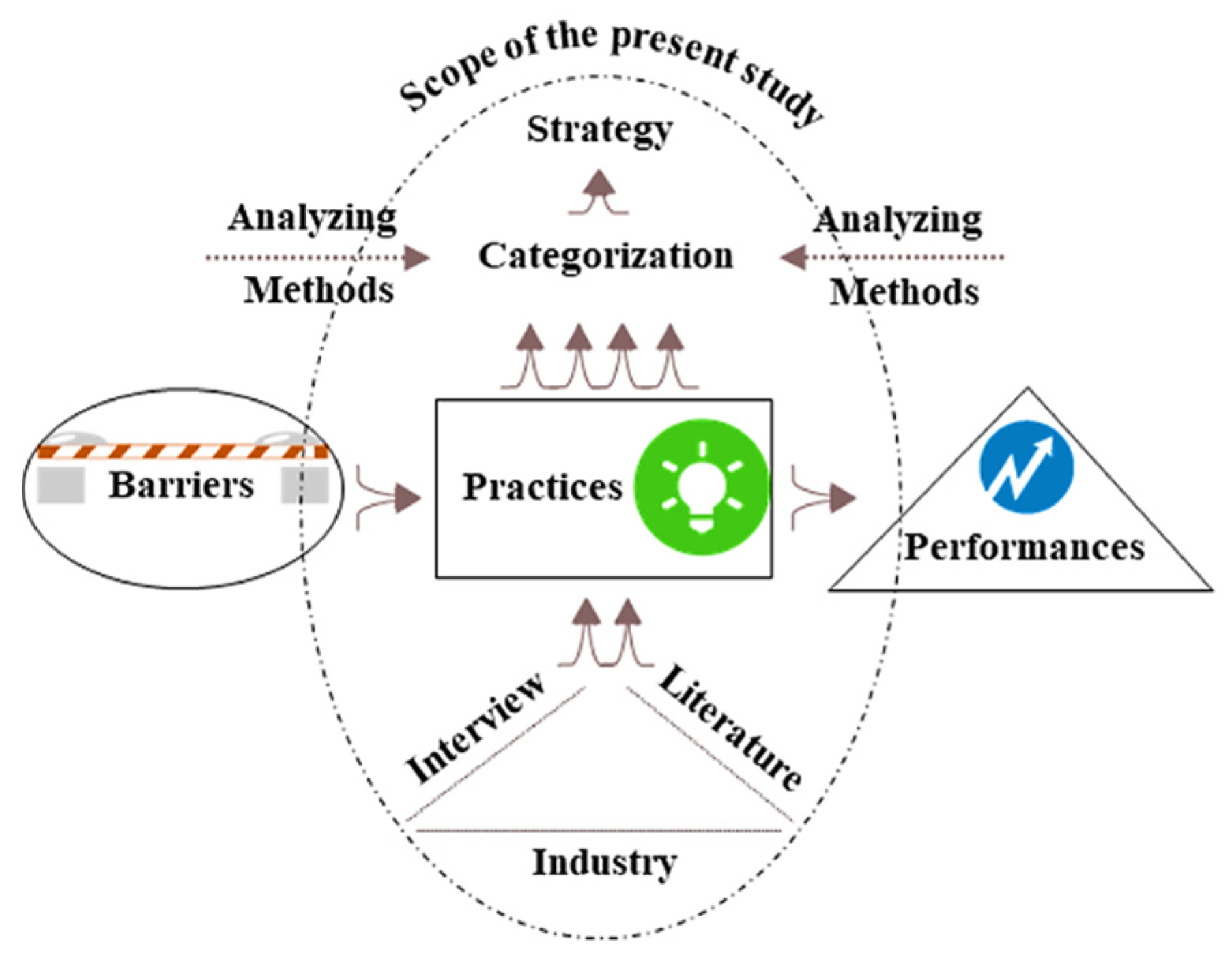
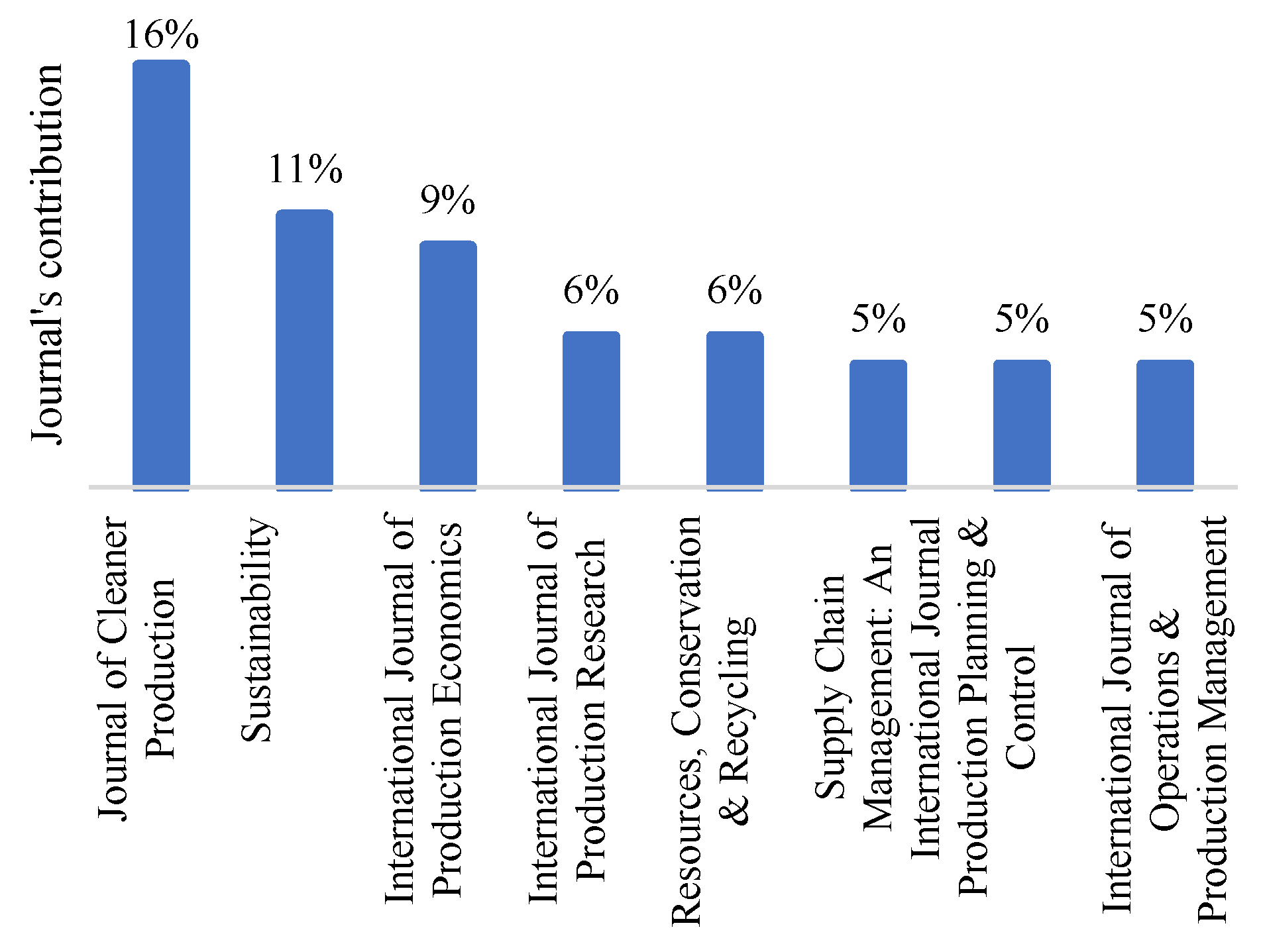
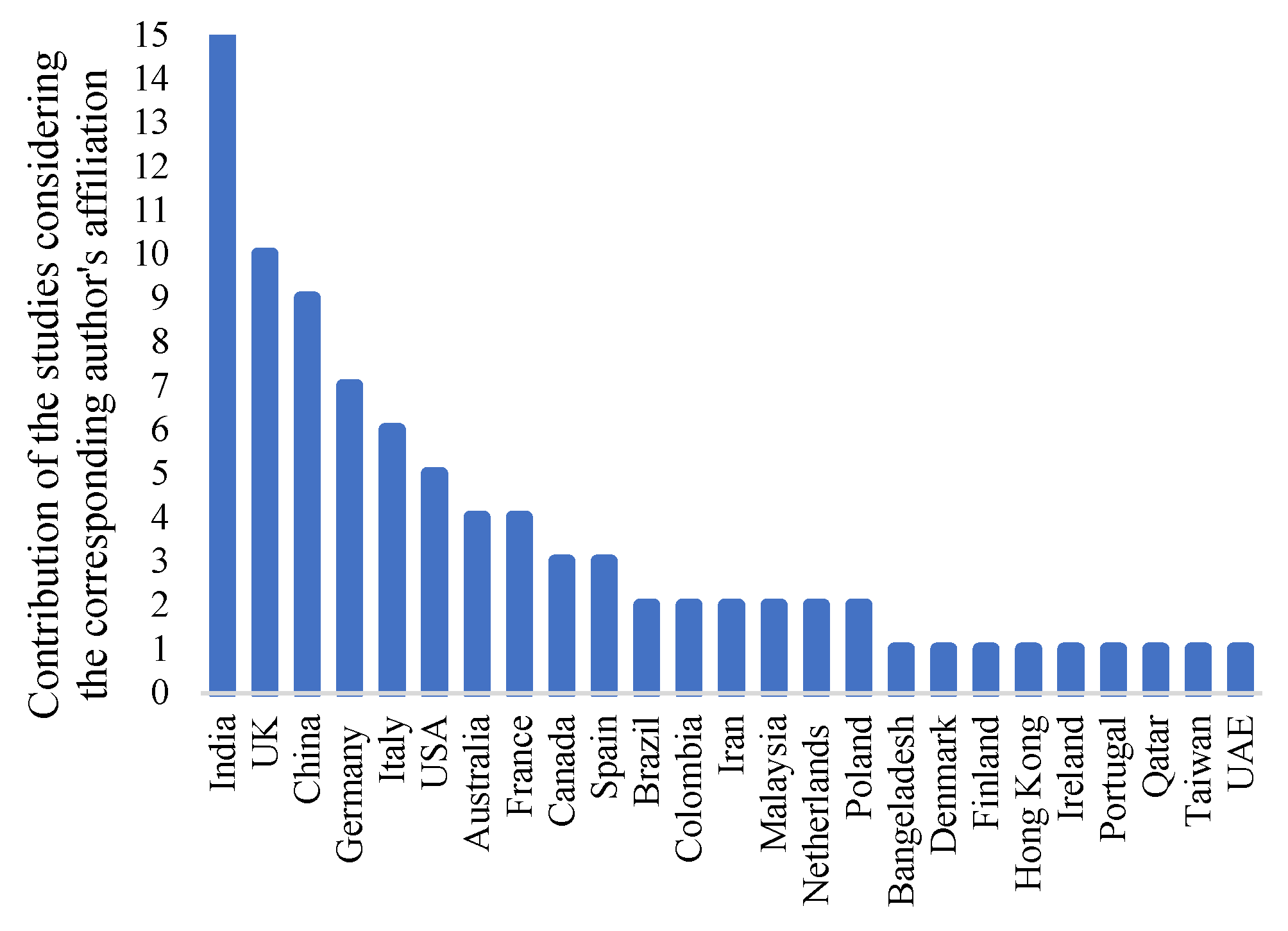
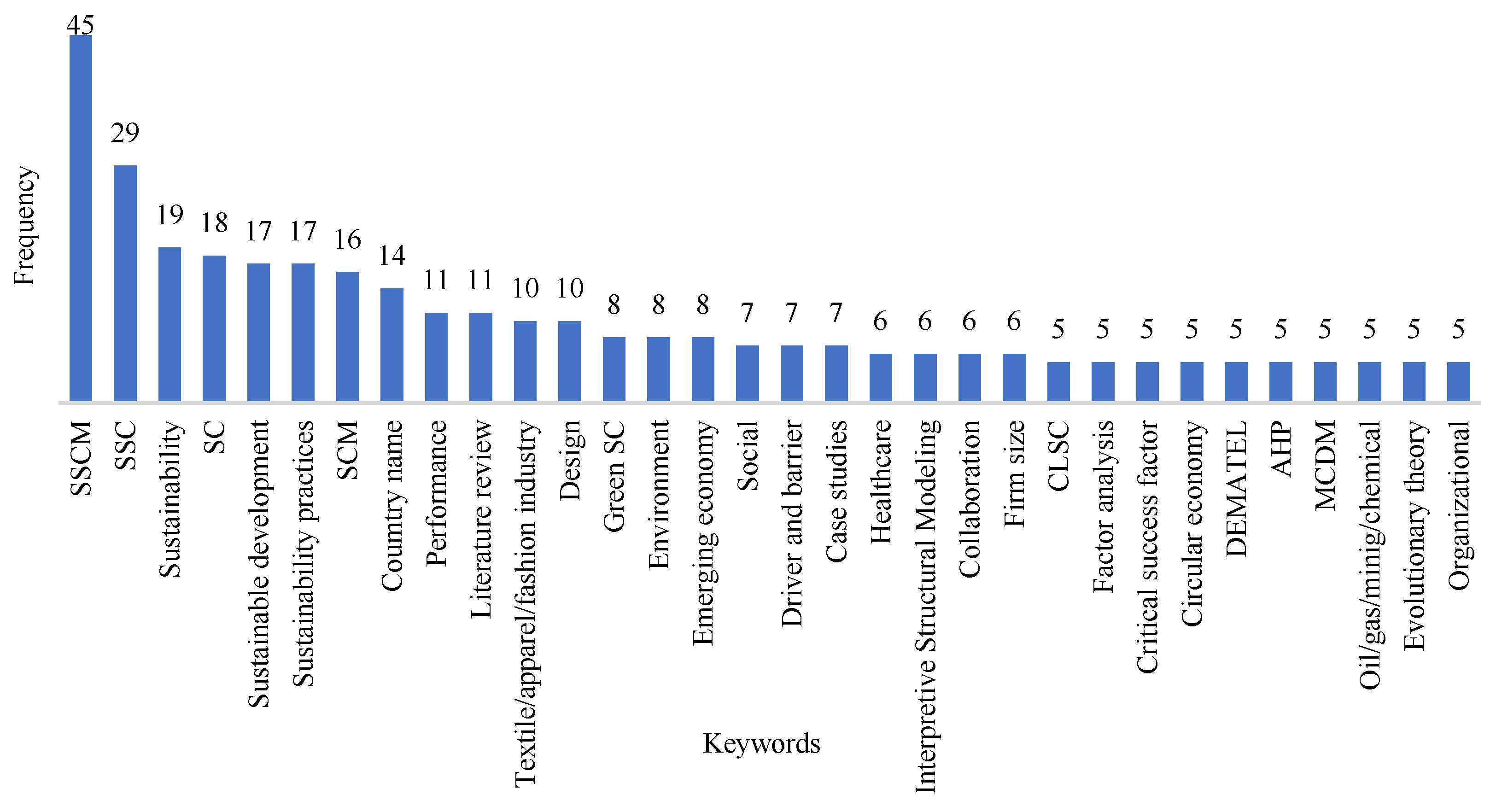


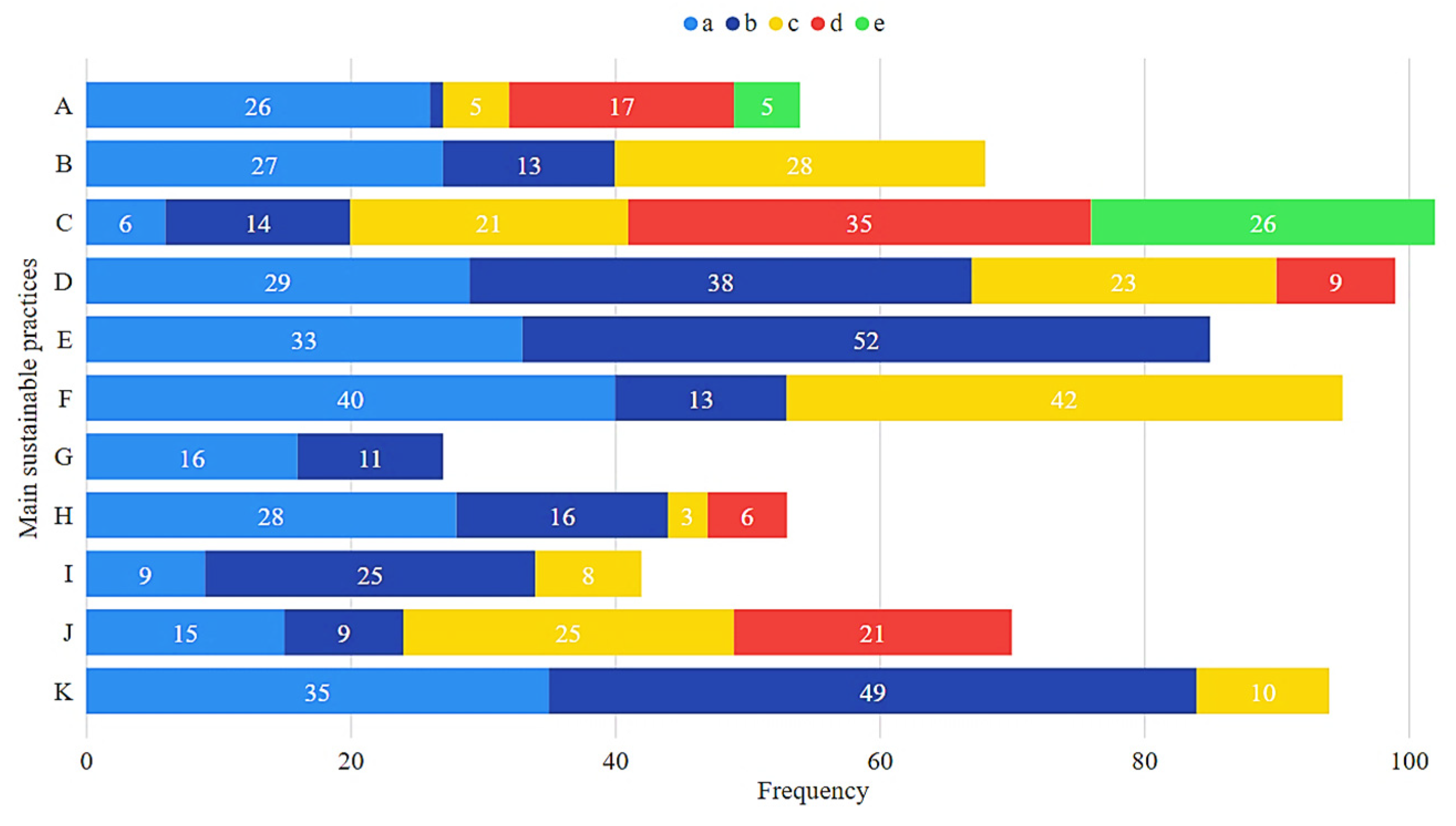
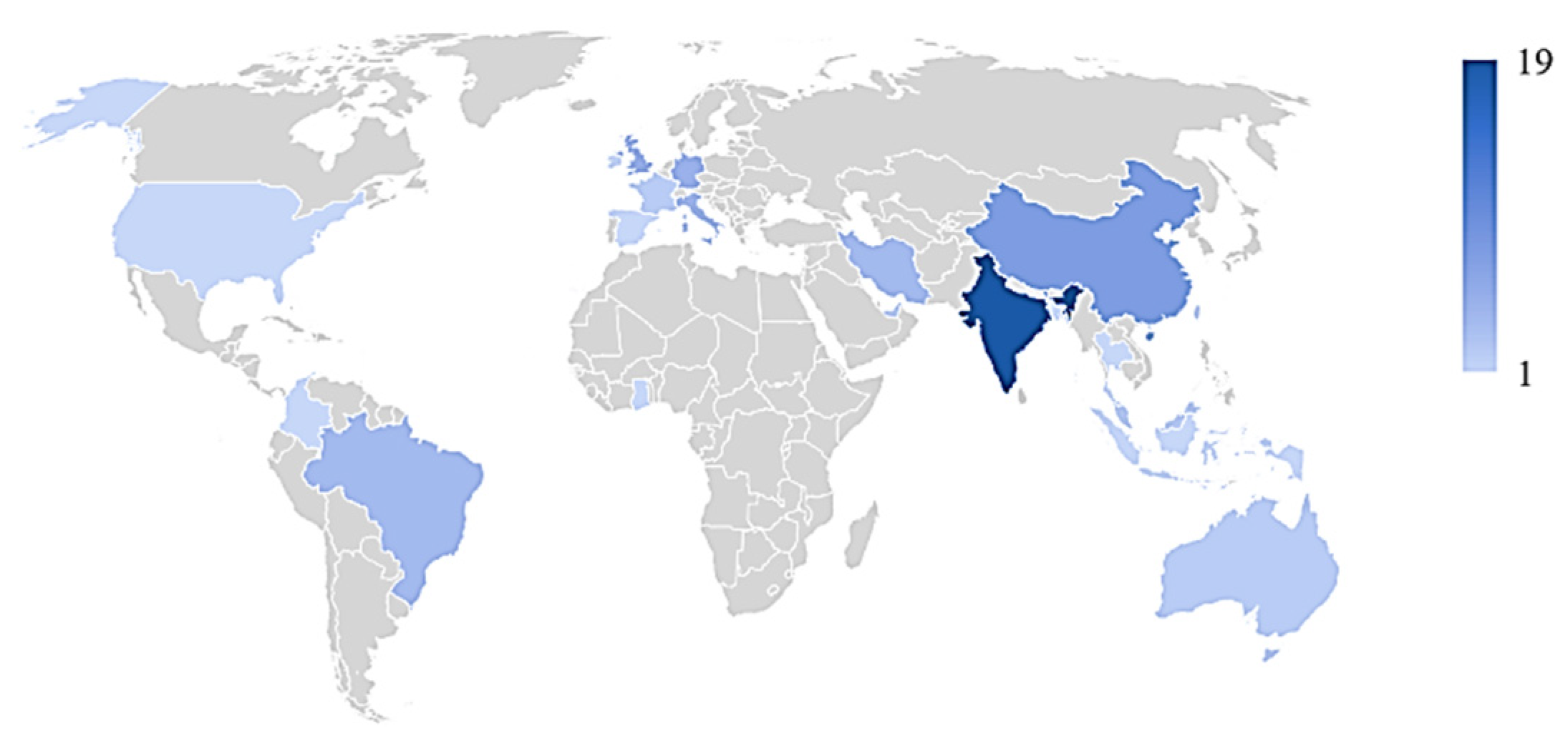
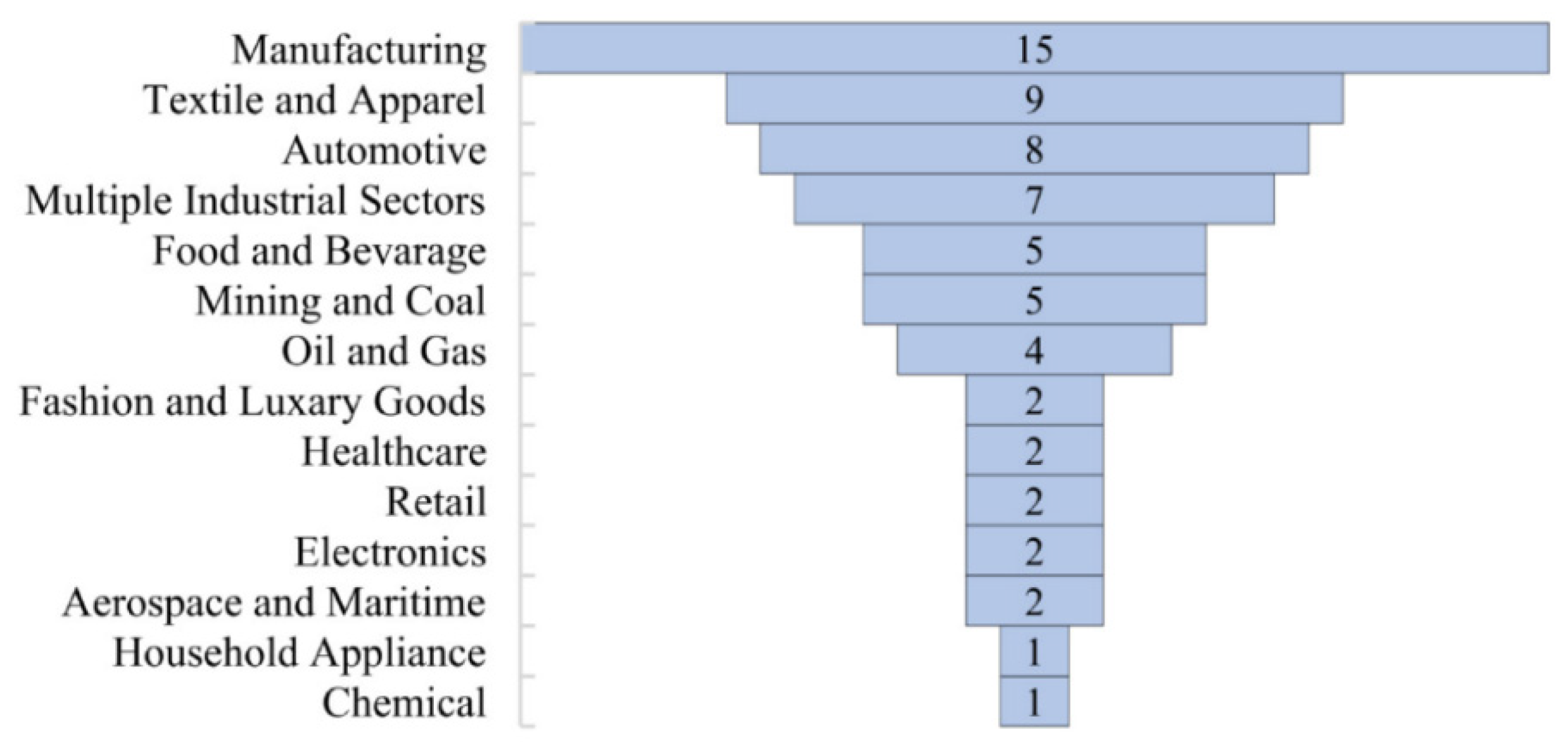
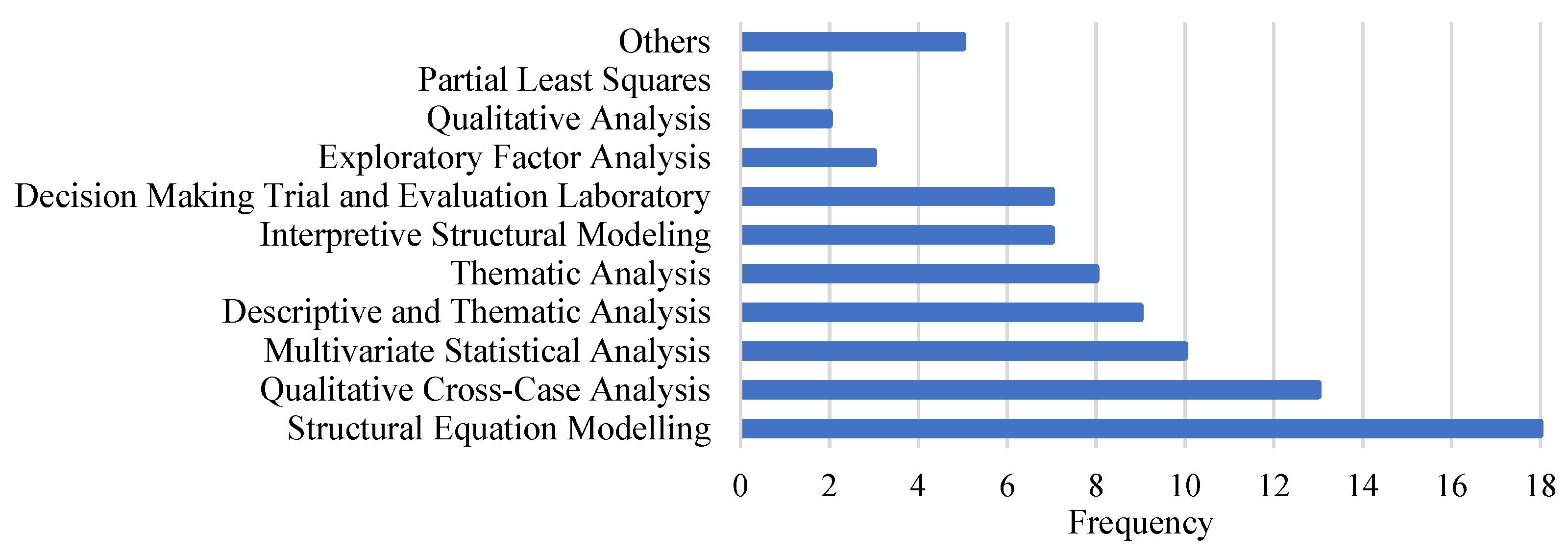
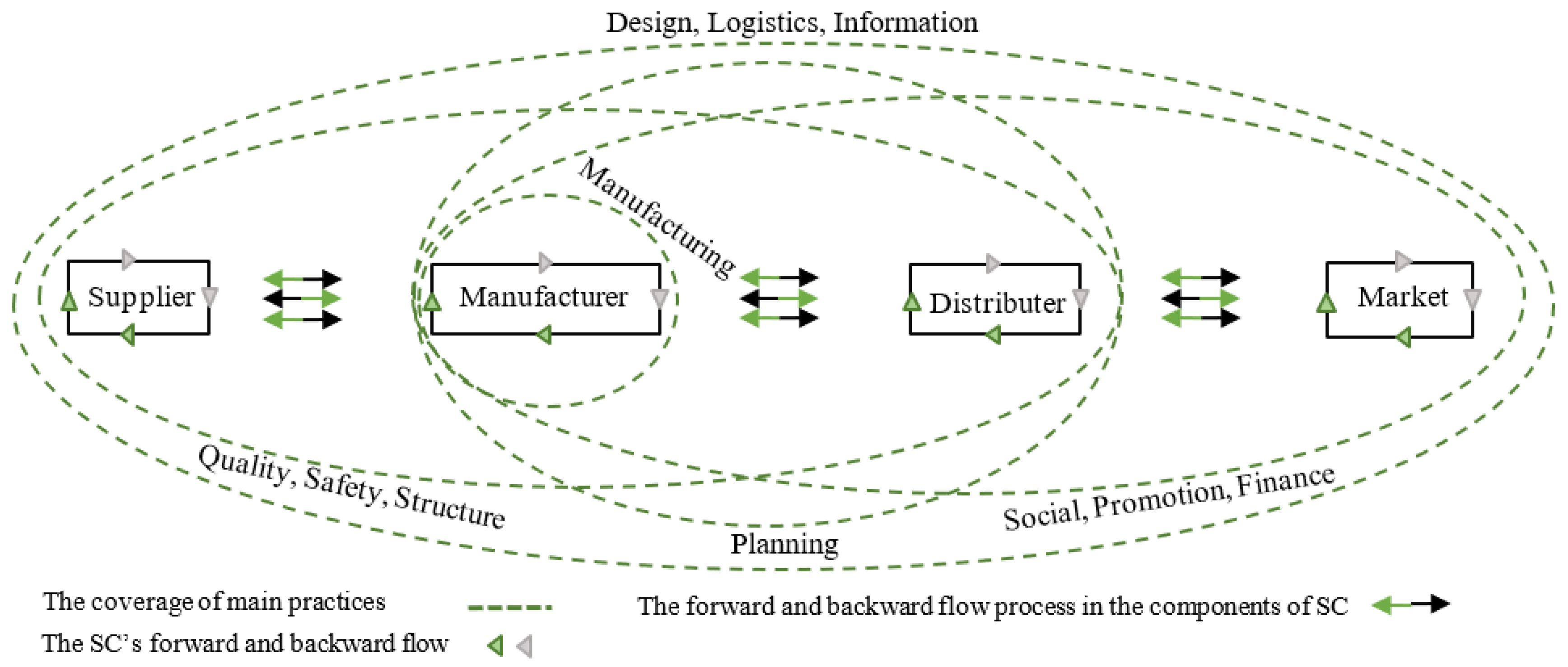
| Industry | ||||||||||||
|---|---|---|---|---|---|---|---|---|---|---|---|---|
| Practice | Aerospace | Chemical | Clothing | Electronics | Energy | Food | Healthcare | Luxury | Manufacturing | Maritime | Retail | Steel |
| Selected | √ | √ | √ | √ | √ | √ | ||||||
| General | √ | √ | √ | √ | √ | √ | √ | |||||
| GSCM | √ | √ | √ | |||||||||
| SSCM | √ | √ | ||||||||||
| Environmental | √ | √ | √ | |||||||||
| Social | √ | √ | √ | √ | ||||||||
| Environmental and Social | √ | √ | √ | |||||||||
| Environmental and Governmental | √ | |||||||||||
| Environmental, Social and Economic | √ | √ | ||||||||||
| ESG factors | √ | |||||||||||
| Digitalization | √ | |||||||||||
| Agile | √ | |||||||||||
| Dynamic capabilities | √ | √ | ||||||||||
| Innovation management | √ | |||||||||||
| Internal and external | √ | √ | √ | √ | ||||||||
| Behavioral | √ | |||||||||||
| Cooperate social responsibility | √ | |||||||||||
Publisher’s Note: MDPI stays neutral with regard to jurisdictional claims in published maps and institutional affiliations. |
© 2022 by the authors. Licensee MDPI, Basel, Switzerland. This article is an open access article distributed under the terms and conditions of the Creative Commons Attribution (CC BY) license (https://creativecommons.org/licenses/by/4.0/).
Share and Cite
Shekarian, E.; Ijadi, B.; Zare, A.; Majava, J. Sustainable Supply Chain Management: A Comprehensive Systematic Review of Industrial Practices. Sustainability 2022, 14, 7892. https://doi.org/10.3390/su14137892
Shekarian E, Ijadi B, Zare A, Majava J. Sustainable Supply Chain Management: A Comprehensive Systematic Review of Industrial Practices. Sustainability. 2022; 14(13):7892. https://doi.org/10.3390/su14137892
Chicago/Turabian StyleShekarian, Ehsan, Behrang Ijadi, Amirreza Zare, and Jukka Majava. 2022. "Sustainable Supply Chain Management: A Comprehensive Systematic Review of Industrial Practices" Sustainability 14, no. 13: 7892. https://doi.org/10.3390/su14137892
APA StyleShekarian, E., Ijadi, B., Zare, A., & Majava, J. (2022). Sustainable Supply Chain Management: A Comprehensive Systematic Review of Industrial Practices. Sustainability, 14(13), 7892. https://doi.org/10.3390/su14137892








